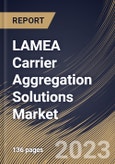The widespread use of extended reality (XR) offerings, including gaming, mixed reality (MR), augmented reality (AR), and virtual reality (VR), is credited with the rise in mobile data traffic. The use of unused spectrum by mobile networks is made possible by carrier aggregation technologies, which widen the channels for data transmission. By combining data carriers, MNOs concentrate on providing higher data peak rates, greater traffic volumes, and the capacity to reduce mobile data traffic to improve user experience.
In order to fulfill the demands of data-hungry programs for both commercial and consumer use cases, 5G carrier aggregation will enhance network performance. Carrier aggregation is essential for achieving increased coverage range since operators want to best use their spectrum holdings in several FDD and TDD bands. In addition, operators can save money due to the decreased requirement for establishing new cell sites. With constant service throughout the network, it also enhances the mobile user experience.
One of the first Middle Eastern countries to introduce 5G networks in 2019 was Saudi Arabia. The Communications and Information Technology Commission (CITC) of Saudi Arabia reported that 60 out of 118 governorates were now served by 5G. The robust growth of the fixed-line internet market in recent years has been facilitated by the rise in social media usage, the growing number of video downloads, and an increase in online gaming as well as streaming as a result of the pandemic. As it seeks greater financing for broadband networks, the government predicts that 97.6% of people will be online by 2026. In addition, due to the liberalization of the spectrum above 1100 GHz and the accessibility of it to operators, the bandwidth of mobile internet has increased to 105.42 Mbps. Currently, Saudi Arabia is rated second among G20 countries and fifth overall.
Furthermore, Saudi Arabia mimicked the FCC's declaration that unlicensed wireless devices would have access to the 6 GHz bands starting in 2021. As a result of its capacity to support 5G NRU-based wireless technologies like next-generation Wi-Fi 6 and others, Kingdom will be well-suited for future improvements in the wireless ecosystem. The regional market is expanding as a result of all these causes.
The Brazil market dominated the LAMEA Carrier Aggregation Solutions Market by Country in 2022 and would continue to be a dominant market till 2029; thereby, achieving a market value of $202 million by 2029. The Argentina market is showcasing a CAGR of 24.9% during (2023-2029). Additionally, The UAE market would register a CAGR of 24% during (2023-2029).
Based on Deployment, the market is segmented into 4G/LTE and 5G & Others. Based on Application, the market is segmented into Mobile Broadband Connectivity, Industrial IoT, Smart City, Maritime Communications, Satellite Communication, and Others. Based on Spectrum Band, the market is segmented into Licensed and Non-licensed. Based on Cell-Type, the market is segmented into Microcells, Femtocells and Picocells. Based on Frequency Band, the market is segmented into Mid-band, Low-band, and High-band. Based on countries, the market is segmented into Brazil, Argentina, UAE, Saudi Arabia, South Africa, Nigeria, and Rest of LAMEA.
The market research report covers the analysis of key stake holders of the market. Key companies profiled in the report include Broadcom, Inc., Verizon Communications, Inc., Cisco Systems, Inc., Telefonaktiebolaget LM Ericsson, Huawei Technologies Co., Ltd. (Huawei Investment & Holding Co., Ltd.), Nokia Corporation, ZTE Corporation, Qualcomm, Inc. (Qualcomm Technologies, Inc.), Anritsu Corporation, and Rohde & Schwarz GmbH & Co. KG.
Scope of the Study
By Deployment
- 4G/LTE
- 5G & Others
By Application
- Mobile Broadband Connectivity
- Industrial IoT
- Smart City
- Maritime Communications
- Satellite Communication
- Others
By Spectrum Band
- Licensed
- Non-licensed
By Cell-Type
- Microcells
- Femtocells
- Picocells
By Frequency Band
- Mid-band
- Low-band
- High-band
By Country
- Brazil
- Argentina
- UAE
- Saudi Arabia
- South Africa
- Nigeria
- Rest of LAMEA
Key Market Players
List of Companies Profiled in the Report:
- Broadcom, Inc.
- Verizon Communications, Inc.
- Cisco Systems, Inc.
- Telefonaktiebolaget LM Ericsson
- Huawei Technologies Co., Ltd. (Huawei Investment & Holding Co., Ltd.)
- Nokia Corporation
- ZTE Corporation
- Qualcomm, Inc. (Qualcomm Technologies, Inc.)
- Anritsu Corporation
- Rohde & Schwarz GmbH & Co. KG
Unique Offerings
- Exhaustive coverage
- The highest number of Market tables and figures
- Subscription-based model available
- Guaranteed best price
- Assured post sales research support with 10% customization free
Table of Contents
Companies Mentioned
- Broadcom, Inc.
- Verizon Communications, Inc.
- Cisco Systems, Inc.
- Telefonaktiebolaget LM Ericsson
- Huawei Technologies Co., Ltd. (Huawei Investment & Holding Co., Ltd.)
- Nokia Corporation
- ZTE Corporation
- Qualcomm, Inc. (Qualcomm Technologies, Inc.)
- Anritsu Corporation
- Rohde & Schwarz GmbH & Co. KG
Methodology

LOADING...








